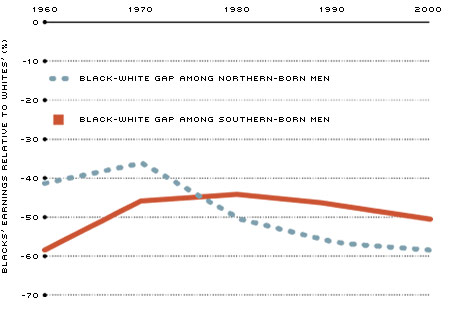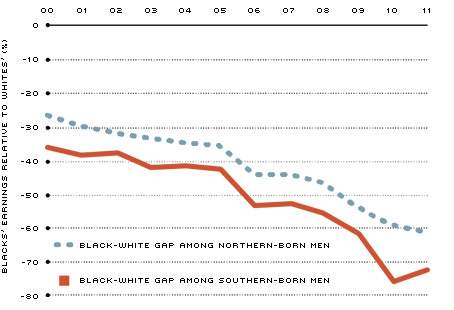Changes in the Racial Earnings Gap since 1960
Income inequality between races has been a widely used indicator of economic prosperity and opportunity (or the lack thereof) within the diverse population of the U.S. The Civil Rights Act of 1964 prohibited discrimination in public places, provided for the integration of schools and other public facilities, and made employment discrimination illegal, thus improving the quality of education and providing more job opportunities for African-Americans. Nevertheless, disparities remain. Labor economists have investigated various sources of earnings inequality in America since the act was passed; some economists have considered how the disparities in earnings change within and across regions of the country. Much of the research covers the 1960-2000 period; much less is known about racial inequality in earnings over the years since. Of particular interest might be the impact of the Great Recession on such inequality.
This article aims to provide insight into the recent trends in earnings inequality between black men and white men. We replicated the analysis in a 2006 study by Jacob Vigdor of the 1960-2000 period using census data and then examined disparities in annual earnings since then, using yearly American Community Survey data from 2000 to 2011.
Relation among Race, Geography and Earnings: 1960-2000

NOTES: The percentages on the vertical axis indicate, for example, that Northern-born black men made in 1960 about 40 percent less than Northern-born white men. Samples are derived from the Integrated Public Use Microdata Series (IPUMS) census data on white and black males age 21-60 born in the 48 contiguous states. Individuals with zero earnings are assumed to have potential earnings below the median for their region/race cell and age. Samples are weighted using IPUMS weights where appropriate.
Relation among Race, Geography and Earnings: 2000-2011

NOTES: The percentages on the vertical axis indicate, for example, that Northern-born black men made in 2000 about 28 percent less than Northern-born white men. Being Northern-born or Southern-born doesn't necessarily mean that the men still live in the North or South, respectively. Samples are derived from the Integrated Public Use Microdata Series (IPUMS) American Community Survey data on white and black males age 21-60 born in the 48 contiguous states. Individuals with zero earnings are assumed to have potential earnings below the median for their region/race cell and age. Samples are weighted using IPUMS weights where appropriate.
Figures 1 (1960-2000) and 2 (2000-2011) present key results. The dotted line shows the percentage differential in earnings for Northern-born black males relative to Northern-born white males, holding constant other variables.[1] (For example, in 1960 Northern-born black males earned on average 40 percent less than their Northern-born white counterparts.) The solid line plots the same comparison between Southern-born blacks and whites. (Be aware that Northern-born and Southern-born does not necessarily mean that the men continued to live in the North or South, respectively.)
In Figure 1, we see that inequality declined among both the Northern-born and Southern-born from 1960 to 1970. Racial earnings inequality among the Northern-born increased markedly from 1970 to 1990 and remained relatively stable from 1990 to 2000. On the other hand, among the Southern-born, racial earnings inequality declined only slightly from 1970 to 1980 and increased slightly from 1980 to 2000. In 2000, black-white earnings inequality among the Northern-born was considerably greater than the level in 1960, while inequality among the Southern-born was reduced.
Figure 2 shows the results for 2000-2011. The values for the Northern-born indicate that the economic situation of blacks (as measured by annual earnings) declined considerably relative to that of whites; in other words, earnings inequality continued to increase for those born outside the South.
Similarly, the percent differential in Southern-born blacks' annual earnings relative to Southern-born whites' worsened over the 2000-2011 period. Those blacks born in the South did not show evidence of converging faster with those blacks born in the North during this decade. In addition, the increases in slope magnitude from 2007 to 2010 indicate that during the Great Recession and in the year following, racial earnings inequality among the Southern-born increased even more than in previous years. Lastly, it is important to note that being a Southern-born black male corresponds with a greater wage differential relative to white counterparts than does being a Northern-born black male. For example, the results indicate that in 2011, the annual earnings of Southern-born black males were approximately 72 percent less than those of Southern-born white males, whereas Northern-born black males' 2011 earnings were 61 percent less than those of Northern-born white males.
What driving forces can explain these trends?
Vigdor examined three hypotheses to understand why it appears that the South demonstrated more rapid progress than the North in reducing the earnings gap between blacks and whites from 1960 to 2000.[2] While each hypothesis seems to have had an effect at some point throughout the 40-year period, the results of his analysis suggest that much of the "improvement" in the racial wage gap in the South was merely a reflection of changing regional demographics—what he calls "selective migration"—and not of actual improvement in relative earnings for Southern-born blacks. The improvements were the result of blacks and whites of differing abilities moving from South to North and vice versa.
Vigdor's results indicate that selective migration accounted for 40 percent of the South's relative improvement from 1960 to 2000 and all of the improvement from 1980 to 2000. More specifically, the black-white wage gap improved among Southern residents but not for those born in the South.
Other studies have attempted to explain the trends in earnings inequality between the races through 2000. A 2010 paper by Dan Black, Natalia Kolesnikova and Lowell Taylor considered the average annual weeks worked from 1970 to 2000 and found that this number declined for black men in each of the 14 cities examined, sometimes by as much as 25 percent, while the declines for white men were relatively smaller. At the same time, black men's weekly hours of work remained stable. Together, these two points suggest that the earnings decline was likely related to labor force attachment (manifested as a drop in the average number of weeks worked in a year) rather than to declines in the number of hours that black men were working. The authors found substantial declines in the proportion of black men employed, increases in the proportion of black men unemployed and even larger increases in the proportion of black men not in the labor force. In other words, black men's labor force trends from 1970 to 2000 help explain why their average annual weeks worked declined and why their total annual earnings declined relative to those of white men.
Yet can these studies by Vigdor and by Black et al. explain the behavior in racial earnings gaps over the 2000-2011 period? While Vigdor argued that selective migration explained the South's improvement in racial earnings inequality relative to the North's, recent research by Greg Kaplan and Sam Schulhofer-Wohl suggests that interstate migration has been decreasing. In other words, the selective migration story observed in previous decades would no longer apply.
An alternative explanation for the increased racial inequality could be that African-American men were disproportionately hit by the Great Recession. Their unemployment rate increased from 8.5 percent to 15.4 percent between December 2007 and December 2011. In comparison, the unemployment rate of white men rose from 3.9 percent to 7.1 percent over the same period.[3] Given these unemployment rates, it is no surprise that for both Southern-born and Northern-born blacks, earnings declined relative to whites during the Great Recession. Furthermore, the fact that the labor force attachment for African-Americans has decreased even more since the Great Recession might help explain the increase in the earnings gap since 2009.
Endnotes
- Vigdor uses the term "North" to refer to Census Bureau regions other than the South. Therefore, the "North" in his study comprises the Northeast, Midwest and West regions. [back to text]
- His second hypothesis is that changes in regional labor markets, following the Civil Rights legislation and the manufacturing decline in the North, improved Southern blacks' economic prosperity. His third hypothesis is that the South's progress in reducing the black-white earnings gap from 1960 to 2000 could be a consequence of greater educational attainment among blacks, following desegregation and the reduction of racial disparity in education. [back to text]
- The unemployment rate data are for black men age 20 and over, seasonally adjusted, and white men age 20 and over, seasonally adjusted, from the U.S. Bureau of Labor Statistics/Haver Analytics. [back to text]
References
Black, Dan A.; Kolesnikova, Natalia A.; and Taylor, Lowell J. "The Economic Progress of African Americans in Urban Areas: A Tale of 14 Cities." Federal Reserve Bank of St. Louis' Review, September/October 2010, Vol. 92, No. 5, pp. 353-79.
Kaplan, Greg; and Schulhofer-Wohl, Sam. "Understanding the Long-Run Decline in Interstate Migration." Federal Reserve Bank of Minneapolis, October 2012 (revised February 2013), Working Paper 697.
Ruggles, Steven; Alexander, J. Trent; Genadek, Katie; Goeken, Ronald; Schroeder, Matthew B.; and Sobek, Matthew. Integrated Public Use Microdata Series (IPUMS): Version 5.0 [Machine-readable database]. Minneapolis: University of Minnesota, 2010.
Vigdor, Jacob L. "The New Promised Land: Black-White Convergence in the American South, 1960-2000." National Bureau of Economic Research, March 2006, Working Paper 12143.
Views expressed in Regional Economist are not necessarily those of the St. Louis Fed or Federal Reserve System.
For the latest insights from our economists and other St. Louis Fed experts, visit On the Economy and subscribe.
Email Us

